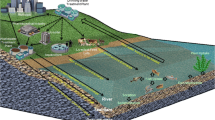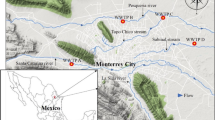Abstract
Concentration levels of six natural and anthropogenic origin steroid estrogens, namely, diethylstilbestrol (DES), estrone (E1), estradiol (E2), estriol (E3), ethinylestradiol (EE2), and estradiol-17-valerate (Ev), from different effluents in Beijing were assessed. Sampling sites include two wastewater treatment plants (WWTPs), a chemical plant, a hospital, a pharmaceutical factory, a hennery, and a fish pool. In general, concentrations of estrogens in the effluents varied from no detection (nd) to 11.1 ng/l, 0.7 to 1.2 × 103 ng/l, nd to 67.4 ng/l, nd to 4.1 × 103 ng/l, nd to 1.2 × 103 ng/l, and nd to 11.2 ng/l for DES, E1, E2, EE2, E3, and Ev, respectively. The concentration levels of steroid estrogens from different effluents decreased in the order of pharmaceutical factory and WWTP inlets > hospital > hennery > chemical factory > fish pool. This study indicated that natural estrogens E1, E2, and E3 and synthetic estrogen EE2 are the dominant steroid estrogens found in the different Beijing effluents. For source identification, an indicator (hE = E3/(E1 + E2 + E3)) was used to trace human estrogen excretion. Accordingly, hE in effluents from the hospital and WWTP inlets exceeded 0.4, while much smaller values were obtained for the other effluents. Human excretions were the major contributor of natural estrogens in municipal wastewater. Estimation results demonstrated that direct discharge was the major contributor of steroid estrogen pollution in receiving waters.
Similar content being viewed by others
References
Andersen, H., Siegrist, H., Halling-Sorensen, B., & Ternes, T. A. (2003). Fate of estrogens in a municipal sewage treatment plant. Environmental Sciences and Technology, 37, 4021–4026.
Baronti, C., Curini, R., D’Ascenzo, G., Di, C. A., Gentili, A., & Samperi, R. (2000). Monitoring natural and synthetic estrogens at activated sludge sewage treatment plants and in a receiving river water. Environmental Sciences and Technology, 34, 5059–5066.
Beardmore, J. A., Mair, G. C., & Lewis, R. I. (2001). Monosex male production in finfish as exemplified by tilapia: Applications, problems, and prospects. Aquaculture, 197, 283–301.
Beijing Statistical Yearbook (2006). Beijing Municipal Bureau of Statistics. www.bjstats.gov.cn/tjnj/2006-tjnj/content/mV98_08-10.htm.
Belfroid, A., Van der, H. A., Vetaak, A., Schäfer, A., Rijs, G., Wegener, J., et al. (1999). Analysis and occurrence of estrogenic hormones and their glucuronides in surface water and waste water in the Netherlands. Science of the Total Environment, 225, 101–108.
Braga, O., Smythe, G., Schafer, A. I., & Feitz, R. J. (2005). Fate of steroid estrogens in Australian inland and coastal wastewater treatment plants. Environmental Sciences and Technology, 39, 3351–3358.
Brown, N., Nagarkatti, M., & Nagarkatti, P. S. (2006). Diethylstilbestrol alters positive and negative selection of T cells in the thymus and modulates T-cell repertoire in the periphery. Toxicology and Applied Pharmacology, 212, 119–126.
Campbell, C. G., Borglin, S. E., Green, F. B., Grayson, A., Wozei, E., & Stringfellow, W. T. (2006). Biologically directed environmental monitoring, fate, and transport of estrogenic endocrine disrupting compounds in water: A review. Chemosphere, 65, 1265–1280.
Chen, C., Wen, T., Wang, G., Cheng, H., Lin, Y., & Lien, G. W. (2007). Determining estrogenic steroids in Taipei waters and removal in drinking water treatment using high-flow solid-phase extraction and liquid chromatography/tandem mass spectrometry. Science of the Total Environment, 378, 352–365.
D’Ascenzo, G., Di, C. A., Gentili, A., Mancini, R., Mastropasqua, R., Nazzari, M., & Samperi, R. (2003). Fate of natural estrogen conjugates in municipal sewage transport and treatment facilities. Science of the Total Environment, 302, 199–209.
Desbrow, C., Routledge, E. J., Brighty, G. C., Sumpter, J. P., & Waldock, M. (1998). Identification of estogenic chemicals in STW effluent. 1. Chemical fractionation and in vitro biological screening. Environmental Sciences and Technology, 32, 1549–1558.
Ford, C. D., Johnson, G. H., & Smith, W. G. (1983). Natural killer cells in in utero diethylstilbesterol-exposed patients. Gynecologic Oncology, 16, 400–404.
Giusti, R. M., Iwamoto, K., & Hatch, E. E. (1995). Diethylstilbestrol revisited: A review of the long-term health effects. Annals Internal Medicine, 122, 778–788.
Gomes, R. L., Acioglu, E., Scimshaw, M. D., & Lester, J. N. (2004). Steroid estrogen determination in sediment and sewage sludge: A critique of sample preparation and chromatographic/mass spectrometry considerations, incorporating a case study in method development. Trends in Analytical Chemistry, 23, 737–744.
Hansen, P. D., Dizer, H., Hock, B., Marx, A., Sherry, J., McMaster, M., et al. (1998). Vitellogenin-a biomarker for endocrine disruptors. Trends in Analytical Chemistry, 17, 448–451.
Hurley, M. A., Matthiessen, P., & Pickering, A. D. (2004). A model for environmental sex reversal in fish. Journal of Theoretical Biology, 227, 159–165.
Jin, S., Yang, F., Liao, T., Hui, Y., & Xu Y. (2008). Seasonal variations of estrogenic compounds and their estrogenicities in influent and effluent from a municipal sewage treatment plant in China. Environmental Toxicology and Chemistry, 27, 146–153.
Johnson, A. C., Belfroid, A., & Di Corcia, A. (2000). Estimating steroid oestrogen inputs into activated sludge treatment works and observations on their removal from the effluent. Science of the Total Environment, 256(2–3), 163–173.
Johnson, A. C., & Sumpter, J. P. (2001). Removal of endocrine-disrupting chemicals in activated sludge treatment works. Environmental Sciences and Technology, 35, 4697–4703.
Labadie, P., & Budzinski, H. (2005). Determination of steroidal hormone profiles along the Jalle d’Eysines River (near Bordeaus, France). Environmental Sciences and Technology, 39, 5113–5120.
Labadie, P., & Budzinski, H. (2006). Alteration of steroid hormone profile in juvenile turbot (Psetta maxima) as a consequence of short-term exposure to 17a-ethynylestradiol. Chemosphere, 64, 1274–1286.
Lai, K. M., Johnson, K. L., Scrimshaw, M. D., & Lester, J. N. (2000). Binding of water borne steroid estrogens to solid phases in river and estuarine systems. Environmental Sciences and Technology, 34, 3890–3894.
Layton, A. C., Gregory, B. W., Seward, J. R., Schultz, T. W., & Sayler, G. S. (2000). Mineralization of steroidal hormones by biosolids in wastewater treatment systems in Tennessee U.S.A. Environmental Sciences and Technology, 34, 3925–3931.
Lee, H. B., & Peart, T. E. (1998). Determination of 17β-estradiol and its metabolites in sewage effluent by solid phase extraction and gas chromatography/mass spectrometry. The Journal of AOAC International, 81(6), 1209–1216.
Lei, B., Huang, S., Zhou, Y., Wang, D., & Wang, Z. (2009). Levels of six estrogens in water and sediment from three rivers in Tianjin area, China. Chemosphere, 76, 36–42.
Legler, J. (2001). Development and application of in vitro and in vivo reporter gene assays for the assessment of (xeno-) estrogenic compounds in the aquatic environment. Department of Toxicology, Wageningen University.
Legler, J., Dennekamp, M., Vethaak, A. D., & Brouwer, A. (2002). Detection of estrogenic activity in sediment-associated compounds using in vitro reporter gene assays. Science of the Total Environment, 293, 69–83.
Lintelmann, J., Katayama, A., Kurihara, N., Shore, L., & Wenzel, A. (2003). Endocrine disruptors in the environment. Pure and Appllied Chemistry, 75, 631–681.
Ma, M., Rao, K., & Wang, Z. (2008). Occurrence of estrogenic effects in sewage and industrial wastewaters in Beijing, China. Environmental Pollution, 147, 331–336.
Maggs, J. L., Grimmer, S. F. M., L’ e-Orme, M., Breckerridge, A. M., Park, B. K., & Gilmore, I. T. (1983). The biliary and urinary metabolites of [3H] 17a-ethynylestradiol in women. Xenobiotica, 13, 421–431.
Orlando, E. F., Kolok, A. S., Binzcik, G. A., Gates, J. L., Horton, M. K., Lambright, C. S., et al. (2004). Endocrine-disrupting effects of cattle feedlot effluent on an aquatic sentinel species, the fathead minnow. Environmental Health Perspectives, 112, 353–358.
Petrovic, M., Solé, M., de Alda, M. J. L., & Barceló, D. (2002). Endocrine disruptors in sewage treatment plants, receiving river waters, and sediments: Integration of chemical analysis and biological effects pm feral carp. Environmental Toxicology Chemistry, 21, 2146–2156.
Pierre, L., & Hélène, B. (2005). Determination of steroidal hormone profiles along the Jalle d’Eysines River (near Bordeaux, France). Environmental Sciences and Technology, 39, 5113–5120.
Purdom, C. E., Hardiman, P. A., Bye, V. J., Eno, N. C., Tyler, C. R., & Sumpter, J. P. (1994). Estrogenic effects of effluents from sewage treatment works. Chemical Ecology, 8, 275–285.
Ranney, R. E. (1977). Comparative metabolism of 17a-ethynyl steroids used in oral contraceptives. Journal of Toxicology and Environmental Health, 3, 139–166.
Reed, M. J., Fotherby, K., & Steele, S. J. (1972). Metabolism of ethynyloestradiol in man. Journal of Endocrinology, 55, 351–361.
Ren, H., Ji, S., Naeem ud din, A., Wang, D., & Cui, C. (2007). Degradation characteristics and metabolic pathway of 17a-ethynylestradiol by Sphingobacterium sp. JCR5. Chemosphere, 66(2), 340–346.
Routledge, E. J., Sheahan, D., Desbrow, C., Brighty, G. C., Waldock, M., & Sumpter, J. P. (1998). Identification of estrogenic chemicals in STW effluent. 2. In vivo responses in trout and roach. Environmental Sciences and Technology, 32, 1559–1565.
Soto, A. M., Calabro, J. M., Prechtl, N. V., Yau, A. Y., Orlando, E. F., Daxenberger, A., et al. (2004). Androgenic and estrogenic activity in water bodies receiving cattle feedlot effluent in eastern Nebraska, USA. Environmental Health Perspectives, 112, 346–352.
Sun, Q., Deng, S., Huang, J., Shen, G., & Yu, G. (2007). Contributors to estrogenic activity in wastewater from a large wastewater treatment plant in Beijing, China. Environmental Toxicology and Pharmacology, 25, 20–26.
Strussmann, C. A., Takshima, F., & Toda, K. (1996). Sex differentiation and hormonal feminization in pejerrey Odontesthes bonariensis. Aquaculture, 139, 31–45.
Ternes, T. A., Kreckel, P., & Mueller, J. (1999). Behaviour and occurrence of estrogens in municipal sewage treatment plants II. Aberobic batch experiments with activated sludge. Science of the Total Environment, 255, 91–99.
Travis, A. H., Donald, A. G., & Ann, C. W. (2003). Manure-borne estrogens as potential environmental contaminants: Review. Environmental Sciences and Technology, 37, 5471–5478.
Zha, J., Sun, L., Zhou Y., Phlip, A. S., Ma, M., & Wang, Z. (2008). Assessment of 17a-ethinylestradiol effects and underlying mechanisms in a continuous, multigeneration exposure of the Chinese rare minnow (Gobiocypris rarus). Toxicology and Appllied Pharmacology, 226, 298–308.
Zhou, Y., Zhou, J., Xu, Y., Zha, J., Ma, M., & Wang, Z. (2009). An alternative method for the determination of estrogens in surface water and wastewater treatment plant effluent using pre-column trimethylsilyl derivatization and gas chromatography/mass spectrometry. Environmental Monitoring and Assessment, 158, 35–49.
Zuo, Y., Zhang, K., & Deng, Y. (2005). Occurrence and photochemical degradation of 17a-ethinylestradiol in Acushnet river estuary. Chemosphere, 63, 1583–1590.
Author information
Authors and Affiliations
Corresponding author
Rights and permissions
About this article
Cite this article
Zhou, Y., Zha, J., Xu, Y. et al. Occurrences of six steroid estrogens from different effluents in Beijing, China. Environ Monit Assess 184, 1719–1729 (2012). https://doi.org/10.1007/s10661-011-2073-z
Received:
Accepted:
Published:
Issue Date:
DOI: https://doi.org/10.1007/s10661-011-2073-z




